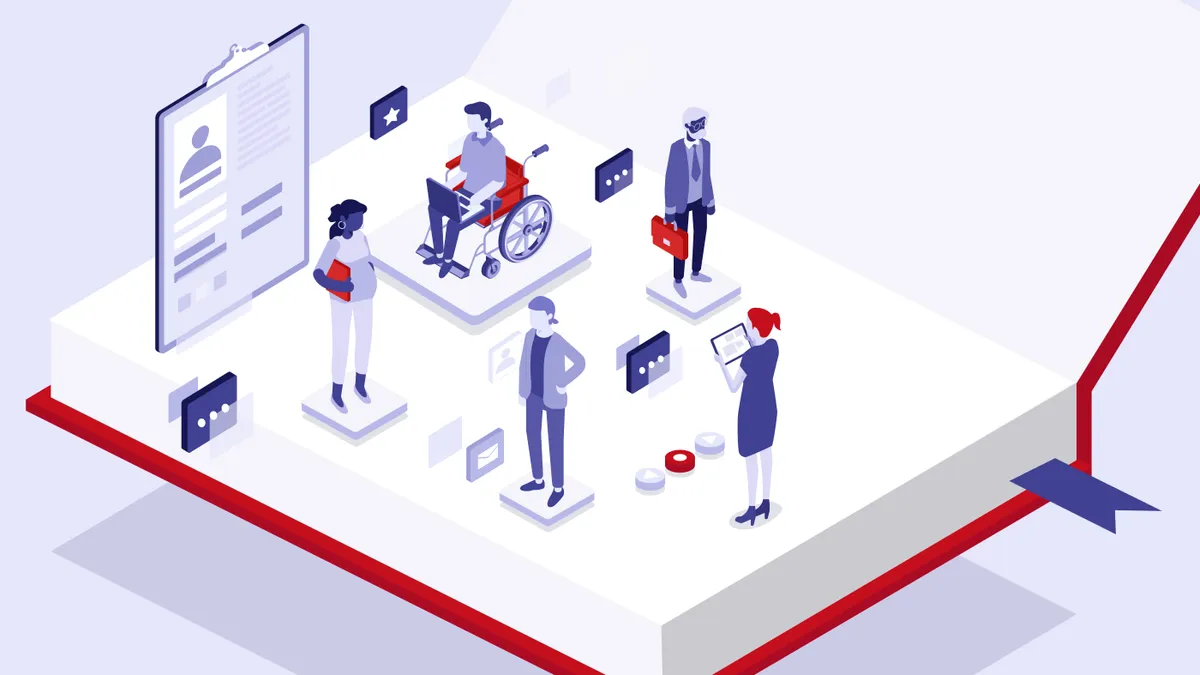For the talent professional and the new hire, anxieties around onboarding don't actually look all that different. Am I going to have all the information I need handy? Will I be able to make myself heard? Will I seem approachable to a new co-worker? Am I going to do a good job at this?
"The anxiety is really the fear or stress of the unknown," said Marc Solow, managing director of human capital, at Deloitte Consulting.
HR Dive has written about onboarding extensively — so if you're new to the field, then you should definitely comb through our coverage — but for this installment of the Talent Textbook, we've pulled together a broad overview of the process with help from a few experts. With a few modern ideas, this one-stop reference (complete with timeline) can assist talent newcomers and C-suiters alike in refreshing their onboarding process.
So here's to making the unknown known: welcome to onboarding.
Before day one
After recruiting an awesome candidate, talent professionals might be tempted to rest on their laurels and let communication lapse, but with the competition for new talent as fierce as it is, HR needs to check in with candidates more frequently prior to day one. It can build on a candidate's excitement after a positive recruiting experience, reassuring them that they made the right choice about their career — and it can prevent poaching.
"They were facing an issue where, after their candidates were accepting offers, if there was a four-week timespan between 'offer accepted' and 'day one,' they didn't have the process to continue the engagement and communication with the candidate, and they were finding their best candidates were getting poached by competition," Solow said, speaking about one of his tech-industry clients.
"They speculated that their candidates were concerned that the recruiting process was one thing, but is the zero-communication, zero-engagement world what it's really like to work at this company?" he said.
Poaching can plague any employer hiring for hot skills, Solow said. Touching base can keep candidates engaged before their start date, especially when some of the communication comes from their actual teams to-be.
"Depending on the size of your company, your onboarding process might be pretty automated, but I think a nice email from their incoming manager, saying, 'I'm so excited that you're going to be working here. I see you, I've been in your shoes before. I know you're coming. I'm prepared for it. I'm excited for it,' that helps a lot," said Loni Freeman, vice president of human resources for SSPR. "I started [a] job when I was younger, and everyone was like, 'Oh, I forgot you were starting today.' That would make someone feel horrible, right? So it's seeing a human connection that's the most important thing."
Encouraging a new hire's future team to connect with them on LinkedIn can help welcome that employee and lessen the fear of the unknown before they start. Sharing paperwork and deadlines via email can also alleviate some of that stress, though Solow cautions that this might be best for salaried rather than hourly workers in order to comply with the Fair Labor Standards Act.
On day one (and into week one)
Back when onboarding was just orientation, day one might have been it. Today, talent professionals craft full-out welcome experiences that stretch into a new hire's third month, covering much more than paperwork. The first day should give new hires a real, thorough introduction to the people, the culture and the role as well as to policies, Freeman said.
"A lot of times when you come in to any organization you get some emails saying, 'Do this, do that,' and maybe you have a mentor if you're lucky who can kind of show you the way," she said. "Whenever I try to revive the process, I think about what I would want as an employee, and that's kind of how the welcome experience has evolved over time."
Along with meeting the CEO within the first week, new hires at SSPR meet all of their co-workers on day one at a casual team breakfast and lunch. Freeman's welcome experience includes chances for hires to learn the nuances of their new workplace with the help of a "curiosity captain," too.
"It's kind of our term for an in-office mentor who's going to give them a tour, who's going to introduce them to everyone, make sure that their laptop works and make sure their mouse has batteries — that they know where the bathrooms are and where all the snacks and the good LaCroix is stashed," Freeman said.
By evaluating onboarding through the eyes of a new employee, talent professionals might also find alternative ways to personalize the process, from paperwork to skills training. To better cater to introverts and extroverts alike, Solow recommends that HR give new hires a mix of self-service and in-person options for completing paperwork, checking in and asking questions. Having choices during onboarding can reduce anxiety, and Freeman has found that making the procedural parts of onboarding more entertaining can also put new hires at ease.
"We have an animated video that talks about what I would consider to be the not-so-glamorous HR policies that come with things," she said. "There's a video of me with a boa on and a cop hat — HR can include some pretty dry topics in general, and so, I want people to get a feeling that I'm not the scary HR lady."
The first 30 days
Even if you're brand new to HR, the 30-day mark might register as a familiar touchpoint. It's the deadline for new employees to enroll in a healthcare plan in the U.S. and it's the point at which talent professionals commonly choose to have their first check-in with a new hire. If a new hire prefers tech to talking in-person, then automation can aid HR during this time, according to Solow.
"It's core to a world-class onboarding process. Most employees don't want to do everything sitting across the desk from an HR professional," he said of HR tech solutions, which can set reminders for deadlines, help HR answer new hires' questions, and send check-in surveys. As a group of "digital natives with digital expectations," the millennial cohort might feel more comfortable with a blend of tech and in-person communication, Solow said.
At this point, new hires have started taking on projects and collaborating with their teams, but they can't be expected to have mastered it all in 30 days. Piling work onto new hires or ignoring their questions is unrealistic and ultimately unproductive. Freeman instead suggests ramping up the workload over time and pushing teams to engage with new hires — even if their industry is fast-paced.
"Initially, some of the challenges are making time to create that kind of collaborative culture because everybody's busy," she said. "And so it's about showing how onboarding people successfully is going to pay off down the road, and how investment of your time now is going to help later."
HR should be proactive about setting expectations for onboarding and then evaluate a new hire's progress accordingly, Solow said. Some employers might want only to require new hires to have mastered certain tools and skills after 30 days, while others might expect them to have fully hit the ground running within the first couple of weeks.
"It's to help them learn about the company and their department and their job, and to make them become as productive as possible, and to a lot of organizations, it's also to drive to high performance over time," he said. "It's taking the longview on onboarding and looking at it from more of a programmatic standpoint, rather than as a series of events."
The first 90 days
Sure, checking in at 30, 60 and 90 days is a good practice, but so is zooming out and continuing to refine the onboarding process, as Solow suggests. After 90 days, talent professionals can move away from evaluating the new hire's performance — how they're handling the workload and assimilating — and start noting their reactions to the onboarding experience itself.
"It's as basic as asking essentially your 'customer' for feedback," Solow said. "One way would be to put together a survey or a recurring set of focus groups with new hires, and ask them 'What worked well? What didn't work well? What was helpful? What wasn't? Is there anything we can do differently?' I can't stress enough how powerful running a set of focus groups or interviews can be."
Empathizing with new hires and recording their pain points is the only way to improve the onboarding process, which could in turn improve overall morale and retention rates. If the feedback on a new onboarding process is good, it's crucial to document it and share it with executives.
"We needed to have a couple of successes under our belt with somebody that came in and did the welcome experience and did great, versus someone that maybe we'd hired previously who felt a little bit lost," said Freeman. Talent professionals at every stage of their career, from entry level to the C-suite, should feel comfortable sharing successes with their CEOs and partnering with them to make onboarding and hiring work better.
"I think no matter where you are on the HR spectrum," she said, "your role is to be a partner in the business, and the CEO is the leader of that business. You need to have a relationship with them no matter what, and they want you to give recommendations and they want you to be in league with the employees to hear what's happening and make recommendations for change."
Correction: A previous version of this article gave an incorrect title for Marc Solow. He is the managing director of human capital at Deloitte Consulting.





















